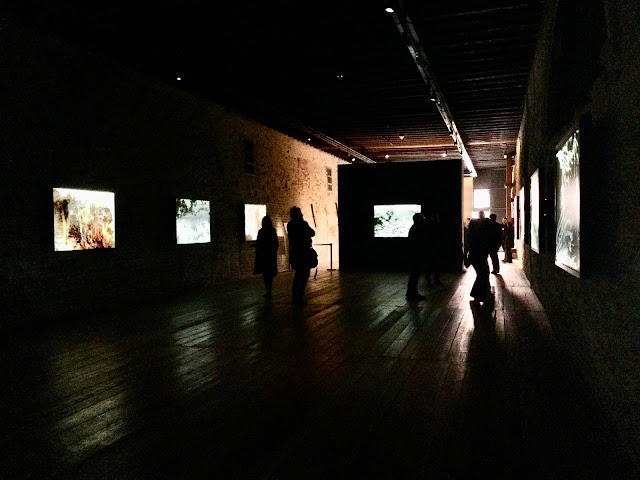 |
| Photographers photographing the photographer Joan Foncuberta at Palazzo Fortuny Inspired by the photographer Prince Francesco Chigi Albani della Rovere Photo: Cat Bauer |
(Venice, Italy) "What is the most decayed photographic material you have?" asked Joan Fontcuberta (Barcelona, 1955) after he was invited to be an artist in residency at the Central Institute for Cataloging and Documentation (ICCD) in Rome. ("Joan" is the male name "John" in the Catalan language.)
Since the late 19th century, the ICCD institute has been the National
Photographic Cabinet that protects and catalogues the cultural heritage of Italy -- the ICCD is part of the Italian Minister of Culture.
So, as preservationists, it created a bit of embarrassment for the ICCD to confess that it did, indeed, have photographic materials that were in poor condition. But they had a good reason.
 |
| Trauma by Joan Fontcuberta - photo of image: Cat Bauer |
What the ICCD had were extremely damaged glass negatives from the Fondo Chigi taken by Prince Francesco Chigi Albani della Rovere (1881, Rome - 1953, Rome), a member of one of the most powerful Italian families in history. The illustrious Chigi Family from Sienna, ennobled in 1377, is rich with prominent members, from bankers to cardinals -- Fabio Chigi became Pope Alexander VII in 1655.
Even though Prince Francesco Chigi came from a wealthy family whose tradition was banking, he was a high school dropout. The youngest of five siblings, he was passionate about nature and the wildlife that populated his Roman villa, birds in particular.Francesco was also passionate about the new medium of photography. How could he capture nature? How could he freeze the vibrant reality he saw twirling around him into photos?
He had the resources to invest in the costly equipment he needed to experiment. He documented his family life and residences, his countryside, his gardens, and his forests, as well as his travels.
 |
| Trauma by Joan Fontcuberta - photo of image: Cat Bauer |
And birds. Lots of birds.
After being neglected and stored in unsuitable locations, much of the aging collection was damaged.
By the time Joan Fontcuberta came on the scene, many of the negatives were almost unrecognizable. This suited him perfectly. "This work is about infection," said Fontcuberta. Damaged by bacteria and other elements over the decades, the photographs were aging and returning to dust. Like humans.
Fontcuberta transformed 12 of the "suffering photographs" into new works of art, all entitled "Trauma." Displayed in light boxes inside the dark, vast ground floor of Palazzo Fortuny are riveting images, part Chigi, part Fontcuberta, that seem to come from the cosmos.
 |
| Joan Fontcuberta. Cultura di polvere at Palazzo Fortuny - Photo: Cat Bauer |
In the catalogue, David Campany explains:
The promise of photography, born at the onset of a rapidly changing modern world, was immortality in the form of the frozen image that would last forever and lend itself to the mastery of history and of progress.
But it was a promise that could not be kept.
It is a cruel if poetic irony that photography, a medium tasked so often with the fixing of appearances and the preservation of history, should turn out to be so materially susceptible.
And, it is perhaps more ironic still that this medium which finds the visual effects of time -- decay, deterioration, mold, putrescence, entropy -- to be so photogenic, should inevitably itself succumb to these effects.
If photographs preserve anything of what they represent, it is only for a short time, and only if the photographs themselves are preserved.
Photography seemed at first impervious and absolute, but it turned out to be human after all: bold, vivacious and unmarked for a while, but eventually frail, decrepit and headed for the grave.
Prince Francesco Chigi original slide - Photo: Cat Bauer
Joan Fontcuberta has taken Francesco Chigi's outcast and unrecoupable photographs and resurrected them from the dust, thrusting them back into the cosmos. He has transformed them into new life forms. It's like he has saved and transmuted their souls.
Be sure to wander into the back room to read the catalogue and gaze at some of the original slides that have been eaten by time.
https://fortuny.visitmuve.it/it/mostre/mostre-in-corso/joan-fontcuberta-cultura-di-polvere/2024/01/19414/mostra-joan-fontcuberta-cultura-di-polvere/
https://fortuny.visitmuve.it/en/mostre-en/mostre-in-corso-en/exhibition-joan-fontcuberta-cultura-di-polvere/2024/01/19430/exhibition-joan-fontcuberta-cultura-di-polvere/
https://fortuny.visitmuve.it/en/mostre-en/mostre-in-corso-en/exhibition-joan-fontcuberta-cultura-di-polvere/2024/01/19430/exhibition-joan-fontcuberta-cultura-di-polvere
Joan Fontcuberta. Cultura di polvere, curated by Francesca Fabiani, has been extended until March 25, Venice's birthday, so you have more time to see the other-worldly images for yourself. Go to Palazzo Fortuny for more information.
Ciao from Venezia,
Cat Bauer
Venetian Cat - The Venice Blog

Fontcuberta transformed 12 of the "suffering photographs" into new works of art, all entitled "Trauma." Displayed in light boxes on the dark, vast ground floor of Palazzo Fortuny are riveting images that seem to come from the cosmos.
ReplyDelete